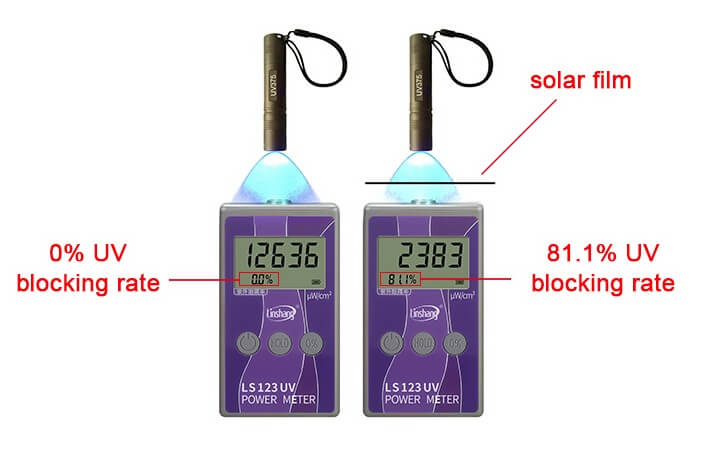UV Power Meter | UV Rejection
In the hot summer, sun protection has become a concern for many car owners. How to choose a stick-stick-film glass with good heat insulation and ultraviolet rejection effect has become a problem for many people. First of all, we must understand that under the sunlight, people sitting in the car feel that their faces are hot. The tanning is due to the excessive exposure of ultraviolet rays. So in order to let the owner experience comfort when driving in the car, we can choose a stick-stick-film glass with good UV rejection effect, that is, a stick-film glass with high UV rejection rate.
I. What is UV rejection rate?
Ultraviolet rejected refers to the percentage of ultraviolet light (300-380nm) in the incident sunlight that is blocked by the window glass system, usually expressed as a percentage. To put it simply, assuming that the incident sunlight is 100 and is blocked by glass by 60, then the UV rejection rate of this glass is 60%. Generally, the higher the UV rejection rate, the better the UV rejection effect of the object. We usually use UV power meter to measure the ultraviolet rejection rate of window film, explosion-proof film, insulating glass and other materials.
II. UV power meter test UV rejection rate
There are various UV power meters on the market. Now we take Linshang UV power meter LS123 with good reputation and cost-effective as an example to give a brief introduction to this instrument for measuring the UV rejection rate. LS123 UV power meter is an instrument with a wide spectrum receiving range. It is mainly used for the measurement of the UV rejection rate of materials. It is suitable for the display of the UV rejection performance of materials such as explosion-proof films, window films and insulating glass. Radiation energy power density measurement of mid-ultraviolet rays, that is, radiation energy power per square meter, the unit is microwatt / square centimeter (μW/cm²).
Measurement accuracy ± 10%
UV rejection rate -999%-100%
Spectral response 260-380nm; λp = 365nm
Photographic aperture ¢ 10mm
Linshang LS123 UV power meter is a professional instrument for measuring UV rejection rate. Its cost performance is extremely high and it only cost $70. If you need to show customers other properties of window film such as infrared rejection effect, you can choose LS122 IR power meter or choose to use SK1150, SK1250, FS2150 window film sales kit.
Linshang Technology as a UV meter manufacturer also provide UV meters that measure the UV light intensity of UV-A, UV-B and UV-C wavelengths. For more inforation, please feel free to contact our sales service : sales21@linshangtech.com!.
III. FAQ about purchasing window film
-
1. What is VLT?
Visible transmittance is the amount of light in the visible portion of the spectrum that passes through a glazing material.The light transmittance of the window film needs to be within the specified range so as not to affect the driver's line of sight. If the visible light transmittance of the window film is too low, traffic accidents are likely to occur. Therefore, when purchasing window film, a window tint meter must be used to measure the transmittance of the window film.
-
2. Does UV tint block heat?
Solar radiation can be divided into three parts: ultraviolet, visible and infrared. The main source of heat is infrared rays in sunlight. Only infrared rays can make people feel the existence of heat directly.
-
3. What is infrared rejection?
Infrared rejection rate refers to the percentage of the infrared light intensity that fails to pass through the material and the infrared light intensity before being put into the test material. We can directly measure the window film with an IR power meter. The infrared rejection rate will be displayed directly without manual calculation. IR Rejection is the amount of solar radiation not transmitted through a glazing system at a particular wavelength or range.
-
4. What is TSER?
TSER refers to the total solar energy rejection rate, that is, the total solar energy blockage of the window film to solar radiation. TSER includes visible light, infrared radiation and ultraviolet energy.
Total Solar Energy Rejected (TSER) is the percentage of the total solar energy that is rejected. TSER includes visible light, infrared radiation and ultraviolet energy. The higher the percentage, the higher the percentage of solar energy deflected. Most tinting shops use Infra Red Rejection (IRR) as a guide to the level of heat rejection. However, IRR only covers a fraction of TSER. Internationally, TSER is used as a guide as it is a more accurate way of measuring heat rejection.
-
5. Does Window Tinting keep your car cooler?
Only good window film can isolate heat and ultraviolet rays, that is, window film with qualified visible light transmittance and high infrared and ultraviolet rejection rate. If you need to measure infrared rejection rate separately, you can choose LS122 IR power meter. If the UV rejection rate is measured separately, you can choose the LS123 UV power meter. For testing the three parameters mentioned above, it is recommended to use the Linshang LS163 series window tint meter.
